OP-ED: It's time to reclaim New York City sidewalks
Crain's New York Business, April 07, 2021
What’s standing in the way of our city’s recovery?
Probably trash. Long the necessary evil with which every city dweller contends, New York’s waste has always been front and center, staring right back at us.
As the pandemic has opened our minds to new, unexpected uses for curb lanes, from outdoor dining to makeshift classrooms to pop-up entertainment venues, it has placed additional demands on curb and sidewalk space degraded by our trash. As spring and summer approach, our streets and sidewalks offer healthy places to socialize, but we need to find a way to deal with refuse so that it has less impact on our streetscape and our planet.
New York City has taken tremendous strides to upgrade its bus stops, kiosks and bike lanes, so why can’t this be done with our waste?
Following the example of Paris and Barcelona, in 2019 the city issued a request for a new container and collection system using the curb lane. Promising design proposals showed it’s possible to separate organics and recyclables, mitigate rat infestations, reduce the time and mileage that a garbage truck spends picking up commercial waste by 85%, and support climate action and Vision Zero goals, with the additional benefit of creating more usable and flexible streetscapes.
In the fall of 2020, the city took the next step by encouraging business improvement districts to take on this challenge through the Clean Curbs Initiative. But transforming trash collection requires the coordination of too many interests and agencies for any BID to tackle the problem alone.
Complicating the picture: Refuse and recycling collection is just one of many competing demands for space at the curb. Other uses include parklets and new restaurant seating we don’t want to give up, as well as the deliveries on which we depend.
But with bold, collective action, our city’s world-class designers, architects, engineers and experts in sanitation can develop systems that treat refuse as a resource, paving the way for more lasting public-space improvements.
The situation demands a coordinated, citywide strategy that looks comprehensively at all the possibilities of this essential piece of public infrastructure. The solution needs to balance public and private use with equity and sustainability in mind. Designing and implementing this new interface between the sidewalk and the street will require a substantial effort, prototypes and pilot programs, just as the bus shelters and bike-share stations we now take for granted once did.
Improving how we handle waste is an ecological imperative that the next mayor must address. Improving our sidewalks’ accessibility and comfort is a social and economic imperative if we are to build back our street life and economy. A comprehensive redesign of our sidewalks and curb lanes with new trash containers and an efficient collection system can achieve both objectives and pay for itself.
The time is now to move our streetscape into a more pedestrian-first future for all of the city.
Guido Hartray is a founding partner at New York-based architecture and landscape architecture firm Marvel. Lian Farhi is a senior transportation planner at engineering, planning and consulting firm Sam Schwartz Engineering.
